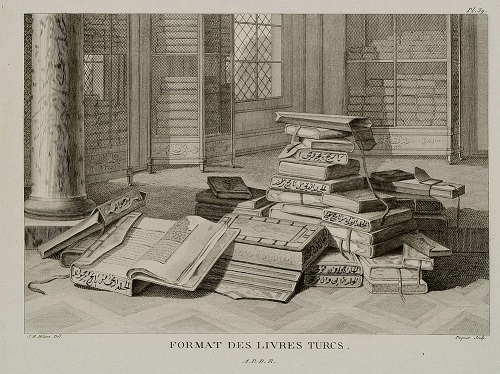TravelTrails: Manuscript Books in 17th Century Constantinople

Antoine Galland (1646–1717) was in Constantinople as a member of the French diplomatic mission of ambassador Charles-Marie-François Olier, known as the Marquis of Nointel (1635–1685).
Along with his diplomatic duties he spent a lot of time with booksellers where he bought books, i.e. manuscripts. In his diary we find interesting information about the movement and prices of books, haggling, but also the reading habits of the Ottomans. His memoirs were published in 1881: Antoine Galland, Journal d'Antoine Galland pendant son séjour a Constantinople [1672-1673] / publié et annoté par Charles Schefer, tt. 1-2, Paris 1881.
As he reports in 1672: "The number of stories and tales in Turkey is impressive. In Europe we marvel at long novels of ten or twelve volumes. The Turks have Alexander's novels in 120 volumes, while others are published in 50, 60 volumes, etc. In the bezesten, there are bookstores that specialize in lending these books to readers for 4 -5 akçe. They have many customers especially during the winter when the nights are long and the Turks love to gather and read such enjoyable stories.”
At another point he mentions that the French ambassador bought two books of Persian poetry, the Gulistan and the Bustan, for 22 piastres. He informs us: "One is written on the margin of the other, with very beautiful colorful Persian characters decorated in gold, it has two images decorated with beautiful vignettes while the first two pages are written on a gold background."
The Bustan (orchard) and the Gulistan (flower garden), written in 1257 and 1258 respectively, are two of the most important works of one of the greatest Persian poets, Sa’di; they contain poems and educational stories. Their influence as a source of wisdom has been profound in both the East and the West.
The first chapter of the Gulistan is preserved in a manuscript codex from the original collection of Joannes Gennadius probably of the 18th century (MSS 175). The entire work contains 5 chapters. MSS 175 is fully bound, is comprised of 60 folios and is written in a large fine calligraphic script. The opening pages are sumptuously decorated. Several small blank frames in red ink in the text possibly indicate that the codex was to be further illuminated; the decoration of the text on the two last folios is also incomplete.
The first two folios containing the beginning of the text are richly illuminated both in the wide margins and around the text with floral motifs, in blue and red ink on a gold background. The other folios of the manuscript are framed in gold, blue and red ink (except for the two leaves after the end of the text framed in red ink only, and the first 4 and the last 6 leaves that are left totally blank). Throughout the text there are some words and marks in red ink.